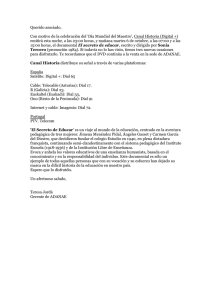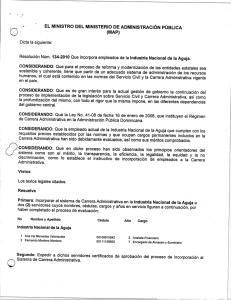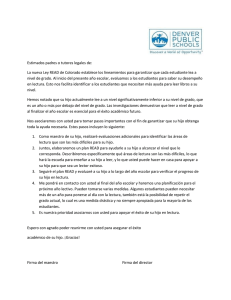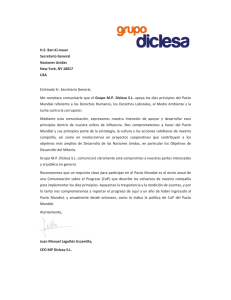gas meter reading guide
Anuncio
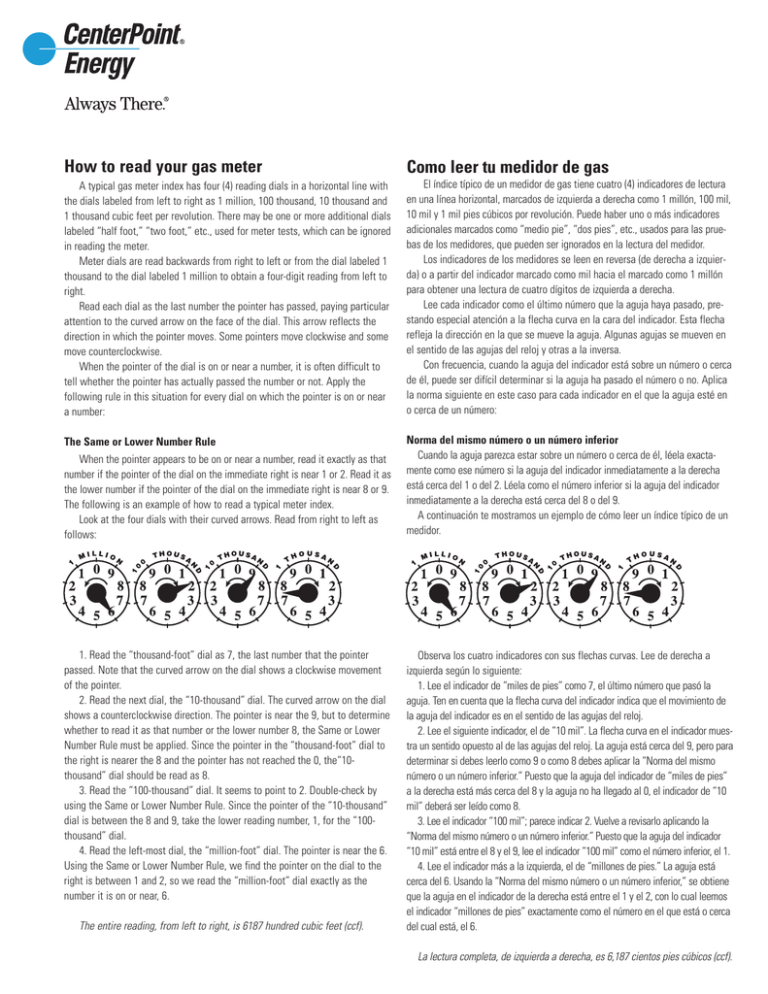
How to read your gas meter Como leer tu medidor de gas A typical gas meter index has four (4) reading dials in a horizontal line with the dials labeled from left to right as 1 million, 100 thousand, 10 thousand and 1 thousand cubic feet per revolution. There may be one or more additional dials labeled “half foot,” “two foot,” etc., used for meter tests, which can be ignored in reading the meter. Meter dials are read backwards from right to left or from the dial labeled 1 thousand to the dial labeled 1 million to obtain a four-digit reading from left to right. Read each dial as the last number the pointer has passed, paying particular attention to the curved arrow on the face of the dial. This arrow reflects the direction in which the pointer moves. Some pointers move clockwise and some move counterclockwise. When the pointer of the dial is on or near a number, it is often difficult to tell whether the pointer has actually passed the number or not. Apply the following rule in this situation for every dial on which the pointer is on or near a number: El índice típico de un medidor de gas tiene cuatro (4) indicadores de lectura en una línea horizontal, marcados de izquierda a derecha como 1 millón, 100 mil, 10 mil y 1 mil pies cúbicos por revolución. Puede haber uno o más indicadores adicionales marcados como “medio pie”, “dos pies”, etc., usados para las pruebas de los medidores, que pueden ser ignorados en la lectura del medidor. Los indicadores de los medidores se leen en reversa (de derecha a izquierda) o a partir del indicador marcado como mil hacia el marcado como 1 millón para obtener una lectura de cuatro dígitos de izquierda a derecha. Lee cada indicador como el último número que la aguja haya pasado, prestando especial atención a la flecha curva en la cara del indicador. Esta flecha refleja la dirección en la que se mueve la aguja. Algunas agujas se mueven en el sentido de las agujas del reloj y otras a la inversa. Con frecuencia, cuando la aguja del indicador está sobre un número o cerca de él, puede ser difícil determinar si la aguja ha pasado el número o no. Aplica la norma siguiente en este caso para cada indicador en el que la aguja esté en o cerca de un número: The Same or Lower Number Rule Norma del mismo número o un número inferior Cuando la aguja parezca estar sobre un número o cerca de él, léela exactamente como ese número si la aguja del indicador inmediatamente a la derecha está cerca del 1 o del 2. Léela como el número inferior si la aguja del indicador inmediatamente a la derecha está cerca del 8 o del 9. A continuación te mostramos un ejemplo de cómo leer un índice típico de un medidor. When the pointer appears to be on or near a number, read it exactly as that number if the pointer of the dial on the immediate right is near 1 or 2. Read it as the lower number if the pointer of the dial on the immediate right is near 8 or 9. The following is an example of how to read a typical meter index. Look at the four dials with their curved arrows. Read from right to left as follows: 1. Read the “thousand-foot” dial as 7, the last number that the pointer passed. Note that the curved arrow on the dial shows a clockwise movement of the pointer. 2. Read the next dial, the “10-thousand” dial. The curved arrow on the dial shows a counterclockwise direction. The pointer is near the 9, but to determine whether to read it as that number or the lower number 8, the Same or Lower Number Rule must be applied. Since the pointer in the “thousand-foot” dial to the right is nearer the 8 and the pointer has not reached the 0, the“10thousand” dial should be read as 8. 3. Read the “100-thousand” dial. It seems to point to 2. Double-check by using the Same or Lower Number Rule. Since the pointer of the “10-thousand” dial is between the 8 and 9, take the lower reading number, 1, for the “100thousand” dial. 4. Read the left-most dial, the “million-foot” dial. The pointer is near the 6. Using the Same or Lower Number Rule, we find the pointer on the dial to the right is between 1 and 2, so we read the “million-foot” dial exactly as the number it is on or near, 6. The entire reading, from left to right, is 6187 hundred cubic feet (ccf). Observa los cuatro indicadores con sus flechas curvas. Lee de derecha a izquierda según lo siguiente: 1. Lee el indicador de “miles de pies” como 7, el último número que pasó la aguja. Ten en cuenta que la flecha curva del indicador indica que el movimiento de la aguja del indicador es en el sentido de las agujas del reloj. 2. Lee el siguiente indicador, el de “10 mil”. La flecha curva en el indicador muestra un sentido opuesto al de las agujas del reloj. La aguja está cerca del 9, pero para determinar si debes leerlo como 9 o como 8 debes aplicar la “Norma del mismo número o un número inferior.” Puesto que la aguja del indicador de “miles de pies” a la derecha está más cerca del 8 y la aguja no ha llegado al 0, el indicador de “10 mil” deberá ser leído como 8. 3. Lee el indicador “100 mil”; parece indicar 2. Vuelve a revisarlo aplicando la “Norma del mismo número o un número inferior.” Puesto que la aguja del indicador “10 mil” está entre el 8 y el 9, lee el indicador “100 mil” como el número inferior, el 1. 4. Lee el indicador más a la izquierda, el de “millones de pies.” La aguja está cerca del 6. Usando la “Norma del mismo número o un número inferior,” se obtiene que la aguja en el indicador de la derecha está entre el 1 y el 2, con lo cual leemos el indicador “millones de pies” exactamente como el número en el que está o cerca del cual está, el 6. La lectura completa, de izquierda a derecha, es 6,187 cientos pies cúbicos (ccf).
